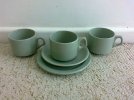What everyday household items are most likely to have been manufactured from scrap metal that was once part of a train?
Around the 1960s, when the railways were undergoing drastic contraction - with line closures and scrapping of large numbers of steam locomotives & surplus rolling-stock - the railways generated huge tonnages of scrap metal each year. To such an extent it distorted the supply & demand operation of the scrap component within the UK steel industry back then.
During that period, there would be:-
- Much less globalised markets for scrap metals. It's likely British scrap mostly (but not entirely) stayed onshore to be recycled in British steel mills.
- More production of commodity raw steel for use by British industry within Britain - rather than focusing on specialised manufacturing high-value steel as now.
- A very much higher proportion of consumer goods & appliances manufactured in Britain for British (and export) markets.
The result would be, if you bought typical British-made consumer durables in the late 1960s & into the '70s - say, a Belling electric oven, a Hotpoint twin-tub washing machine, or a Bulldog garden spade - there's a good chance that some proportion of the iron within might have come from a Black 5, or parts of four-wheel coal wagons, or rails recovered from the Southern's 'Withered Arm'. Of course, you'd never know from exactly where, or how much of it was in there.
If a mere 5.5g of ex-railway iron had found its way into fabrication of your washing machine, or new Austin Maxi, that's still around a whopping 60,000,000,000,000,000,000,000 'railway' atoms.
These days, the Korean, Indian or Chinese steel in your washing machine or 4x4 vehicle might still contain some recycled train - just not a familiar British train.
Speaking of recycling materials - Bill Bryson's book
A Short History of Nearly Everything talks about 'recycled' atoms which go to make up the human body . . .
Bill Bryson said:
Every atom you possess has almost certainly passed through several stars and been part of millions of organisms on its way to becoming you.
We are each so atomically numerous and so vigorously recycled at death that a significant number of our atoms - up to a billion for each of us, it has been suggested - probably once belonged to Shakespeare.
A billion more each came from Buddha and Genghis Khan and Beethoven, and any other historical figure you care to name.
So we are all reincarnations - though short-lived ones. When we die, our atoms will disassemble and move off to find new uses elsewhere - as part of a leaf or other human being or drop of dew.”
Presumably the billion atoms Bryson is referring to are mainly carbon, oxygen, hydrogen, plus a few other lighter elements, which would be readily circulated in gaseous form. The calcium atoms from Beethoven's bones and the lead which allegedly poisoned him are much less mobile and presumably have generally stayed within the vicinity of his grave (at least over the almost 200 years since his death).
The hypothesis also suggests that it's not just admirable historical celebrities like Shakespeare, Buddha and Beethoven we share our atoms with. The 'vigorous mixing process' after death also means we each probably have another billion or so atoms which were once part of Jack the Ripper's and Adolf Hitler's bodies.

